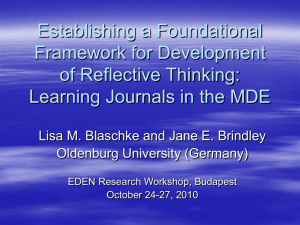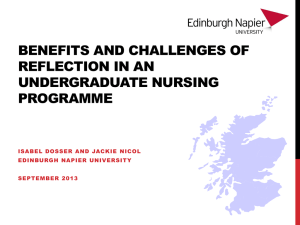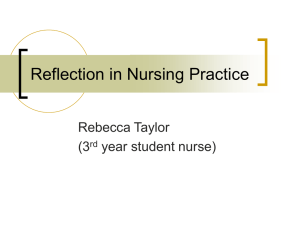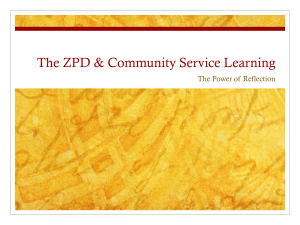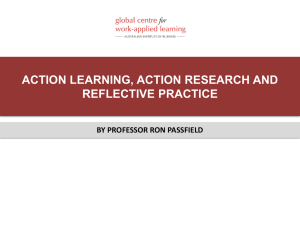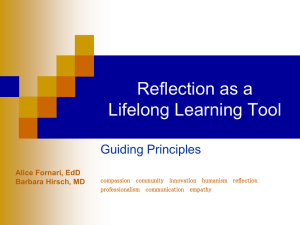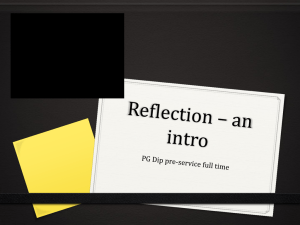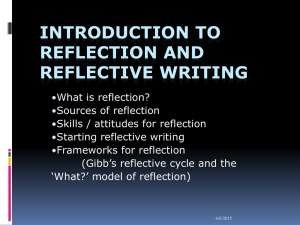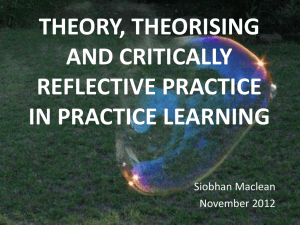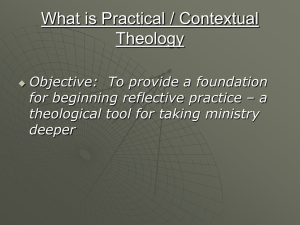Mann Walsh oxford2
advertisement
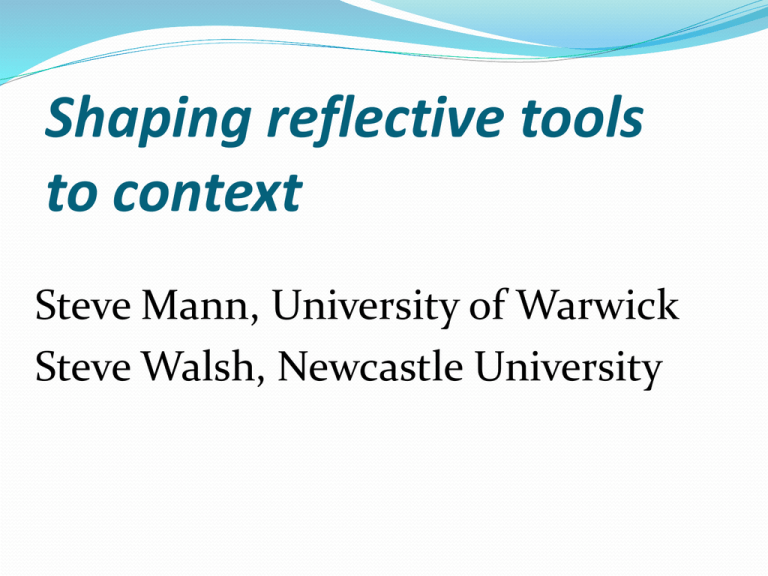
Shaping reflective tools to context Steve Mann, University of Warwick Steve Walsh, Newcastle University Reflective practice Case for reflective practice (RP) and critical reflective practice (CRP) is wellestablished. RP/CRP are now at the heart of a number of teacher education programmes (preservice teacher training (e.g. CELTA) to to MA as well as ongoing CPD. Teachers’ ability to reflect on practice, to analyze and to act are crucial. The orthodoxy of reflection in TESOL Dewey’s initial vision of ‘reflective thinking’ in the ‘educational process’ (Dewey 1933) Schön’s (1983) view of the ‘reflective practitioner’ Richards & Nunan (1990) and Wallace (1991) Translated into TESOL by publications such as (e.g. Bailey, Curtis & Nunan 2001, Farrell 2007), Action research (e.g. Freeman 1998, Burns 1999, Edge 2001) Orthodox but vague ‘it is hard to keep up with the continuous stream of new contributions on reflection in the teaching profession’ (Bengtsson 1995: 24). It has become ‘unclear what constitutes reflective practice’ and the notion of reflective practice has lost its ‘sharpness of meaning’ (Morrison, 1995: 82) Shifting attention from written to spoken? Written accounts are arguably an administrative account or record rather than an indicator that reflection is ongoing. Also, problem of ‘faking it’ (Hobbs 2007). CRP as a process lends itself to dialogue and coconstructed meaning-making. Developing understandings, acquiring new knowledge and skills, and implementing professional practices perhaps best occur through dialogue and discussion over time. In investigating spoken reflective interaction we are concerned with… Provision of space Roles Norms of interaction (discourse choices) Tasks/activities/tools Kurtuglu-Hooton (2010: 37) ‘A teacher educator colleague’: “The lesson may not be perfect but with honest reflection and evaluation trainees should be able to change what didn't work well for better practice in the next lesson.” Reflection and evaluation – uneasy bedfellows? Criteria-led – evaluative in nature Trainers procedures and discursive practices learnt through community of practice (Lave & Wenger 1991). Trainers have participatory structures they evoke in feedback that are for them ‘normal and unremarkable’. (Copland 2010: 471) Walsh (2006) There is a clear and evident gap between student and staff perceptions of CRP and the reasons for its existence. Students (typically) operate at a ‘surface’ level which addresses the ‘here and now’ of their professional lives: how to plan a lesson, how to collect information for an assignment, how to ensure that written records are kept up to date. In contrast, and, not surprisingly given their more extensive professional experience, staff are considering the ‘bigger picture’, operating at a deep level where CRP is advocated as an artefact which underpins professional practice. Appropriate tools Walsh (2006) SETT grid aims at developing an appropriate ‘metalanguage’ facilitating description and reflection on practice. promotes, through collaborative dialogue, changes in practice. in-action and on-action Difference between reflection-in-action and reflection-on-action. Reflection-in-action arises in classroom situations where the teacher has to rethink, tweak, improvise, or reorient aspects of the lesson. Stimulated recall is particularly useful in recalling such reflection-in-action and tying it to the more general Four balances Balance between Narcissus and Icarus (Edge 2011) Direction and Reflection (Farr 2011) Monologic and Dialogic (Mann and Copland 2010) IRF and Rogerian Discourse (Edge 2002) Icarus and Narcissus Icarus had wings and flew higher than he should. Narcissus stayed too long observing himself and put down roots. ‘the mutually-shaping interactions between our roots and our wings, our self-knowledge and our environmental knowledge’ provide awareness so that we can ‘commit ourselves to future action based on that combined awareness’ (Edge 2011:17) Towards the dialogic Dialogic talk creates more space for extended turns, reflective talk, peer contributions (Mann and Copland 2010) it encourages participants to move from an interpsychological to an intra-psychological stage of development. the dialogic – inter /intra inter-psychological stage of development occurs through dialogue and ‘making public’ experiential knowledge, emergent understanding and articulations Participants may then reflect on and learn from these discussions, internalizing and appropriating new meanings, new understandings (intra-psychological stage of development) Conclusions Students need to be taught how to reflect critically and this should become a key element of all teacher education programmes. Students need appropriate tools and a metalanguage. However, reflection does not have to be criteria-led or always based on critical evaluation, there can be space for other kinds of discourse. Need more attention to ‘levels of reflective activity’ and how different discourses, roles, task and tools encourage reflection
